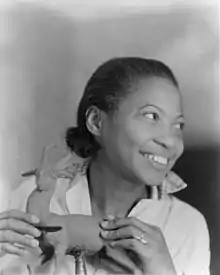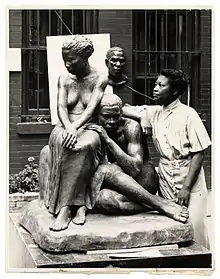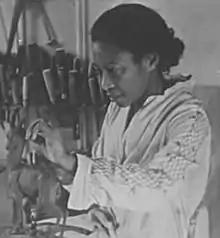Augusta Savage
Augusta Savage (born Augusta Christine Fells; February 29, 1892 – March 27, 1962) was an American sculptor associated with the Harlem Renaissance.[2] She was also a teacher whose studio was important to the careers of a generation of artists who would become nationally known. She worked for equal rights for African Americans in the arts.[3]
Augusta Savage | |
|---|---|
 Augusta Savage | |
| Born | Augusta Christine Fells February 29, 1892 Green Cove Springs, Florida |
| Died | March 27, 1962 (aged 70)[1] New York |
| Nationality | American |
| Education | Cooper Union, Académie de la Grande Chaumière |
| Known for | Sculpture |
Notable work | Gamin W.E.B Dubois Lift Every Voice and Sing |
| Movement | Harlem Renaissance |
| Spouse(s) | John T. Moore James Savage Robert L.Poston |
| Patron(s) | Teachers from Florida A&M, Julius Rosenwald Fund |
Early life and work
Augusta Christine Fells was born in Green Cove Springs (near Jacksonville), Florida on February 29, 1892, to Edward Fells, a Methodist minister, and Cornelia Murphy.[4] Augusta began making figures as a child, mostly small animals out of the natural red clay of her hometown, Green Cove Springs Florida.[2] Her father was a poor Methodist minister who strongly opposed his daughter's early interest in art. "My father licked me four or five times a week,” Savage once recalled, “and almost whipped all the art out of me.”[5] This was because at that time, he believed her sculpture to be a sinful practice, based upon his interpretation of the "graven images" portion of the Bible.[6] She persevered, and the principal of her new high school in West Palm Beach, where her family relocated in 1915,[7] encouraged her talent and allowed her to teach a clay modeling class.[8] This began a lifelong commitment to teaching as well as to creating art.

In 1907 Augusta Fells married John T. Moore. Her only child, Irene Connie Moore, was born the following year. John died shortly thereafter.[7] In 1915, she married James Savage;[9][10] she kept the name of Savage throughout her life. After their divorce in the early 1920s, Augusta Savage moved back to West Palm Beach.[7]
Savage continued to model clay, and in 1919 was granted a booth at the Palm Beach County Fair where she was awarded a $25 prize and ribbon for most original exhibit.[7] Following this success, she sought commissions for work in Jacksonville, Florida, before departing for New York City in 1921.[7] She arrived with a letter of recommendation from the Palm Beach County Fair official George Graham Currie for sculptor Solon Borglum and $4.60.[8] When Borglum discovered that she could not afford tuition at the School of American Sculpture, he encouraged her to apply to Cooper Union, a scholarship-based school, in New York City where she was admitted in October 1921.[2] She was selected before 142 other men on the waiting list.[11] Her talent and ability so impressed the Cooper Union Advisory Council that she was awarded additional funds for room and board when she lost the financial support of her job as an apartment caretaker.[7] From 1921 through 1923, she studied under sculptor George Brewster.[8] She completed the four-year degree course in three years.[4]
In 1923 Savage applied for a Summer art program sponsored by the French government; although being more than qualified, she was turned down by the international judging committee solely because they refused to award a spot to a Black person.[12] Savage was deeply upset and questioned the committee, beginning the first of many public fights for equal rights in her life. Though appeals were made to the French government to reinstate the award, they had no effect and Savage was unable to study at the Fontainebleau School of Fine Arts.[2] The incident got press coverage on both sides of the Atlantic, and eventually, the sole supportive committee member sculptor Hermon Atkins MacNeil – who at one time had shared a studio with Henry Ossawa Tanner – invited her to study with him. She later cited him as one of her teachers.
After completing studies at Cooper Union, Savage worked in Manhattan steam laundries to support herself and her family. Her father had been paralyzed by a stroke, and the family's home destroyed by a hurricane. Her family from Florida moved into her small West 137th Street apartment. During this time she obtained her first commission for a bust of W. E. B. Du Bois for the Harlem Library. Her outstanding sculpture brought more commissions, including one for a bust of Marcus Garvey. Her bust of William Pickens Sr., a key figure in the NAACP, earned praise for depicting an African American in a more humane, neutral way as opposed to stereotypes of the time, as did many of her works.[13]
In 1923 Savage married Robert Lincoln Poston, a protégé of Garvey.[14] Poston died of pneumonia aboard a ship while returning from Liberia as part of a Universal Negro Improvement Association and African Communities League delegation in 1924. In 1925 Savage won a scholarship to the Royal Academy of Fine Arts in Rome. This scholarship covered only tuition, and she was not able to raise money for travel and living expenses. Thus, she was unable to attend. In the 1920s writer and eccentric Joe Gould became infatuated with Savage. He wrote her "endless letters," telephoned her constantly, and wanted to marry her. Eventually, this turned to harassment.[15]
Savage won the Otto Kahn Prize in a 1928 exhibition at The Harmon Foundation with her submission Head of a Negro.[2] Yet, she was an outspoken critic of the fetishization of the "negro primitive" aesthetic favored by white patrons at the time. She publicly critiqued the director of The Harmon Foundation, Mary Beattie Brady, for her low standards for Black art and lack of understanding in the area of visual arts in general.[16]
In 1929 with pooled resources from the Urban League, Rosenwald Foundation, a Carnegie Foundation grant, and donations from friends and former teachers, Savage was able to travel to France when she was 37.[17] She lived on Montparnasse and worked in the studio of M. [Félix] Benneteau [-Desgrois]. While the studio was initially encouraging of her work, Savage later wrote that "...the masters are not in sympathy as they all have their own definite ideas and usually wish their pupils to follow their particular method..." and began primarily working on her own in 1930.[18]
Knowledge of Savage's talent and struggles became widespread in the African-American community; fundraising parties were held in Harlem and Greenwich Village, and African-American women's groups and teachers from Florida A&M all sent her money for studies abroad. In 1929, with assistance as well from the Julius Rosenwald Fund, Savage enrolled and attended the Académie de la Grande Chaumière, a leading Paris art school. In Paris, she studied with the sculptor Charles Despiau.[19] She exhibited and won awards in two Paris Salons and one Exposition. She toured France, Belgium, and Germany, researching sculpture in cathedrals and museums.
Later work
Savage returned to the United States in 1931, energized from her studies and achievements. The Great Depression had almost stopped art sales. She pushed on, and in 1934 became the first African-American artist to be elected to the National Association of Women Painters and Sculptors.[20] She then launched the Savage Studio of Arts and Crafts, located in a basement on West 143rd Street in Harlem. She opened her studio to anyone who wanted to paint, draw, or sculpt. Her many young students included the future nationally known artists Jacob Lawrence, Norman Lewis, and Gwendolyn Knight. Another student was the sociologist Kenneth B. Clark whose later research contributed to the 1954 Supreme Court decision in Brown v. Board of Education that ruled school segregation unconstitutional. Her school evolved into the Harlem Community Art Center; 1500 people of all ages and abilities participated in her workshops, learning from her multi-cultural staff, and showing work around New York City. Funds from the Works Progress Administration helped, but old struggles of discrimination were revived between Savage and WPA officials who objected to her having a leadership role.[21]
Savage was one of four women and only two African Americans to receive a professional commission from the Board of Design of the 1939 New York World's Fair.[2] She created Lift Every Voice and Sing (also known as "The Harp"), inspired by the song by James Weldon and Rosamond Johnson. The 16-foot-tall plaster sculpture was the most popular and most photographed work at the fair; small metal souvenir copies were sold, and many postcards of the piece were purchased. The work reinterpreted the musical instrument to feature 12 singing African-American youth in graduated heights as its strings, with the harp's sounding board transformed into an arm and a hand. In the front, a kneeling young man offered music in his hands.[22] Savage did not have funds to have it cast in bronze or to move and store it. Like other temporary installations, the sculpture was destroyed at the close of the fair.[22]

Savage opened two galleries whose shows were well attended and well reviewed, but few sales resulted and the galleries closed. The last major showing of her work occurred in 1939.[2] Deeply depressed by her financial struggle, in the 1940s Savage moved to a farmhouse in Saugerties, New York. While in Saugerties, she established close ties with her neighbors and welcomed family and friends from New York City to her rural home. Savage cultivated a garden and sold pigeons, chickens, and eggs. The K-B Products Corporation, the world's largest growers of mushrooms at that time, employed Savage as a laboratory assistant in the company's cancer research facility. She acquired a car and learned to drive to enable her commute. Herman K. Knaust, director of the laboratory, encouraged Savage to pursue her artistic career and provided her with art supplies. Savage created and taught art and sculpted friends and neighbors. Her last commissioned work was for Knaust and was that of the American journalist and author Poultney Bigelow, whose father, John, was U.S. Minister to France during the Civil War. Her few neighbors said that she was always making something with her hands.[23]
Much of her work is in clay or plaster, as she could not often afford bronze. One of her most famous busts is titled Gamin which is on permanent display at the Smithsonian American Art Museum in Washington, D.C.; a life-sized version is in the collection of the Cleveland Museum of Art. At the time of its creation, Gamin, which is modeled after a Harlem youth, was voted most popular in an exhibition of over 200 works by black artists.[24] Her style can be described as realistic, expressive, and sensitive. Though her art and influence within the art community are documented, the location of much of her work is unknown.
In 1945 Savage moved to Saugerties, New York.[25] She taught art to children and wrote children's stories.[4] Savage died of cancer on March 26, 1962, in New York City. While she was all but forgotten at the time of her death, Savage is remembered today as a great artist, activist, and arts educator; serving as an inspiration to the many that she taught, helped, and encouraged.[22]
Legacy
The Augusta Fells Savage Institute of Visual Arts, a Baltimore, Maryland public high school, is named in her honor.
In 2001 her home and studio in Saugerties, New York were listed on the New York State and National Register of Historic Places as the Augusta Savage House and Studio. It is the most significant surviving site associated with the productive life of this renowned artist, teacher, and activist. Her home has been restored to evoke the period when she lived there, and serves to interpret her life and creative vision.[26]
In 2007 the City of Green Cove Springs, Florida nominated her to the Florida Artist Hall of Fame; she was inducted the Spring of 2008. Today at the actual location of her birth, there is a Community Center named in her honor.
A biography of Augusta Savage intended for younger readers has been written by Alan Schroeder. In Her Hands: The Story of Sculptor Augusta Savage[27] was released in September 2009 by Lee and Low, a New York publishing company.
The papers of Augusta Savage are available at the Schomburg Center for Research in Black Culture at New York Public Library.[3]
Works
Individual exhibitions
- Grande Chaumiere, Paris, 1929
- Salon d'Automne, Paris, 1930
- Argent Galleries, New York and Art Anderson Gallery, New York, 1932
- Argent Galleries, New York and New York World's Fair, 1939
- New York Public Library, 1988[17]
Selected group exhibitions
- Argent Galleries, New York, 1934
- Argent Galleries, New York, 1938
- American Negro Exposition, Tanner Art Galleries, Chicago, 1940
- Newark Museum, New Jersey, 1990
- Three Generations of African-American Women Sculptors, Afro-American Historical and Cultural Museum, Philadelphia, 1996[17]
See also
Further reading
- Farris, Phoebe, ed. (1999). Women Artists of Color : A bio-critical sourcebook to 20th century artists in the Americas. Greenwood Press. ISBN 0313303746, pp. 272, 339–344.
- Savage, Augusta (1988). "Augusta Savage and the art schools of Harlem". Schomburg Center for Research in Black Culture. New York Public Library. OCLC 645284036.
- Etinde-Crompton, Charlotte, Crompton, Samuel Willard (2019) Augusta Savage: Sculptor of the Harlem Renaissance. ISBN 9781978505360
- DailyArt Magazine: Augusta Savage: The Woman That Defined 20th Century Sculpture
References
- Harris-Lopez & Janet Witalec, project ed. ; foreword by Trudier (2003). Harlem renaissance (1 ed.). Detroit (Mich.): Gale. p. 551. ISBN 978-0787666187.CS1 maint: multiple names: authors list (link)
- Farrington, Lisa E. (2005). Creating Their Own Image: The History of African-American Women Artists. New York: Oxford University Press, Inc. pp. 100. ISBN 0-19-516721-X.
- Frederick, Candice (2016-01-14). "Black Women Artists: Augusta Savage". The New York Public Library. Retrieved 2018-03-24.
- Augusta Savage. By: Kalfatovic, Martin R., American National Biography (from Oxford University Press), 2010
- "Augusta Savage | Smithsonian American Art Museum". americanart.si.edu. Retrieved 2017-03-11.
- Heller, Jules; Heller, Nancy (1995). North American Women Artists of the Twentieth Century. New York: Garland. pp. 490. ISBN 0-8240-6049-0.
- "American National Biography Online". www.anb.org. Retrieved 2017-03-16.
- Heller, Nancy G., Women Artists: An Illustrated History, Abbeville Press, Publishers, New York 1987 ISBN 978-0-89659-748-8
- Florida State Division of Cultural Affairs http://dos.myflorida.com/cultural/programs/florida-artists-hall-of-fame/augusta-savage/
- 1920 US Census, taken January 17–19, for 916 Banyan Street, West Palm Beach, Florida: James Savage, 25, born Florida, occupation Chauffeur for Private Family; Augusta Savage, 27, born Florida, occupation Laundress for Private Family; Irene Moore, 12. Augusta's father born in Florida, mother born in North Carolina. 6/5/1917 WWI draft registration card shows James Savage, at 916 Banyan, W Palm Beach FL, living with wife and child, Married, African race.
- Palmer, Colin A. (2006). Encyclopedia of African-American Culture and History (2nd ed.). Detroit: illian Reference, USA. p. 2011. ISBN 978-0-02-865816-2.
- Bearden & Henderson, AHOAA, p. 169–170
- Challenge of the Modern: African-American Artists 1925–1945. 1. New York, NY: The Studio Museum in Harlem, New York. 2003. ISBN 0-942949-24-2.
- Ancestry.com shows Florida Divorce Index dated 1941 for James Savage from Augusta, in Palm Beach County.
- Lepore, Jill, "Joe Gould's Teeth: The long-lost story of the longest book ever written". The New Yorker, 07-27-2015
- Bey, Sharif (2017). "Augusta Savage: Sacrifice, Social Responsibility, and Early African American Art Education". Studies in Art Education. 58 (2): 125–140. doi:10.1080/00393541.2017.1292383 – via Taylor & Francis Online.
- Hillstrom, Laurie Collier; Hillstrom, Kevin (1999). Contemporary women artists. Detroit: St. James Press.
- Women artists of the Harlem Renaissance. Kirschke, Amy Helene. Jackson [Mississippi]. 2014. p. 159. ISBN 9781628460339. OCLC 874902125.CS1 maint: others (link)
- Arna Alexander Bontemps; Jacqueline nvielle-Bontemps, eds. (2001). "African-American Women Artists: An Historical Perspective". Black feminist cultural criticism. Keyworks in cultural studies. Malden, Mass: Blackwell. p. 142. ISBN 0631222391.
- Bracks, Lean'tin (2012). African American Almanac. Canton, MI: Visible Ink Press. ISBN 9781578593231.
- AHOAAA p. 174.
- "Augusta Savage". Biography. Retrieved 2017-03-11.
- AHOAAA, p. 179.
- Black Women of the Harlem Renaissance Era. London, United Kingdom: Rowman & Littlefield. 2014. p. 193. ISBN 978-0-8108-8542-4.
- Women artists of the Harlem Renaissance. Kirschke, Amy Helene. Jackson. 2014-08-04. ISBN 9781626742079. OCLC 861671304.CS1 maint: others (link)
- "National Register Information System". National Register of Historic Places. National Park Service. March 13, 2009.
- Schroeder, Alan (2014). In her hands: the story of sculptor augusta savage. Place of publication not identified: Lee & Low Books. ISBN 978-1600609893.
- "Lift Every Voice and Sing, (White metal cast with black patina)". Building on the Legacy: African American Art from the Permanent Collection. Muscarelle Museum of Art. 2017–2018. Retrieved 20 Jun 2018.
- Bontemps, pp. 141–142
- "Collections - SAM - Seattle Art Museum". www1.seattleartmuseum.org. Archived from the original on 2018-02-18. Retrieved 2018-02-17.
External links
| Wikimedia Commons has media related to Augusta Savage. |
| Wikiquote has quotations related to: Augusta Savage |
- Schomburg Center
- Smithsonian Archives
- Gamin
- PBS: Art Focus
- Artnet
- About.com: Women's History
- Negro Artist
- Book Rags
- Green Cove Spring
- Florida Artist Hall of Fame
- 1939 New York World's Fair
- Augusta Savage at Find a Grave
- Profile on NPR Morning edition 7/15/19